
David Leventhal, founding dancer of Dance for PD, helps a student
learn a new move.
Credit: Amber Star Merkens
In 2001, the Mark Morris Dance Group opened a new purpose-based building in Brooklyn, New York. The company wanted to serve their immediate community, and they did that through Dance for PD, a program that teaches dance to those affected by Parkinson’s disease. One of the founding dancers and the current Dance for PD Program Director, David Leventhal, has been a part of the Mark Morris Dance Group since 1997 and has taken part in more than 40 of Morris’ dances. Winner of the 2010 Bessie (New York Dance and Performance Award) for his performance career, David passionately preaches about the power of dance to help those living with Parkinson’s disease with more than just physical movements. He believes that dance has the ability to enhance the participants’ social, emotional and mental faculties as well.
Twenty years after the program’s inception, Dance for PD is now a world-renowned program with a presence of over 300 communities in 26 countries. Even with COVID-19 restrictions, the remote nature of classes has allowed even more people living with PD to experience the benefits of dance.
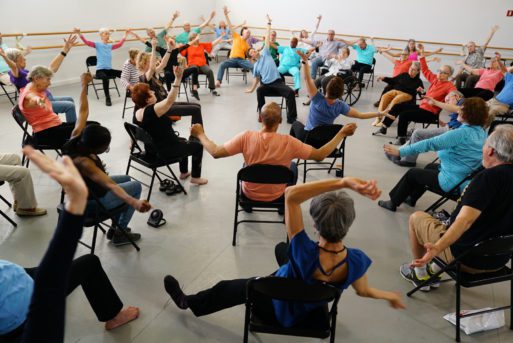
A Dance for PD class
Credit: Amber Star Merkens
What was it like to build a program from the ground up?
It started with a spark and a building. The Mark Morris Dance Group opened a new purpose-built dance building in Brooklyn. We wanted the center to be open to those in the community. A woman named Olie Westheimer who ran a Parkinson’s support group and had a dance background reached out to us. She had a hunch that dance could be beneficial for members of her group. I had done a lot of teaching already as a dancer in the company. I was interested, but I didn’t know anything about Parkinson’s.
In the beginning, we would teach a class and then sit with the participants afterward and ask them what worked and what didn’t. It was their feedback, and Olie’s, that helped us build the curriculum that eventually became Dance for PD. The give-and-take nature of those first sessions helped us understand the need for adaptability in the Parkinson’s community. Everyone comes to the class with different levels of comfort and mobility. They have different symptoms and challenges, and we, as teaching artists, must stay as flexible as we can to offer different versions of moves so everyone can reap the benefits.
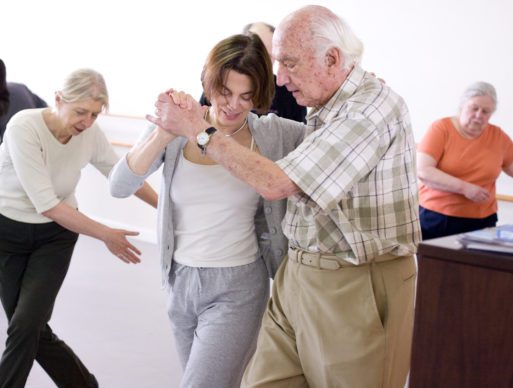
Olie Westheimer dances with a participant at a Dance for PD class.
Do the participants come to class alone or with a relative or caregiver?
Both. About half of the class comes alone and the other half come with a care partner — that could be a spouse or healthcare aide. Some dancers come with their children or grandchildren. We encourage people to bring others to class. Not only is their partner another support for that person as they participate in class, but they’re now able to see their loved one who has Parkinson’s at their best. The participants are smiling, moving with a rhythm and fluidity that may be lacking throughout their other daily activities. They get to express themselves and feel powerful and engaged. Partners love seeing their loved ones with PD in that capacity. Dance class is pretty frustration-free.
Why do you still do this 20 years later?
There’s an element of immense satisfaction in seeing those encountering dance for the first time in their life engage with an art form that I’ve loved for 40 years. They’re gaining a physical benefit and overall sense of well-being from the class. Within minutes, dancers move with better rhythm and musicality than they have in years. I love seeing people learn new things and have the confidence to keep doing them. Over time, there have been periods when dance wasn’t accepted as a complementary or supportive activity, but within the past eight years, the medical community has seen the benefits of including dance as part of a therapy for those living with Parkinson’s.
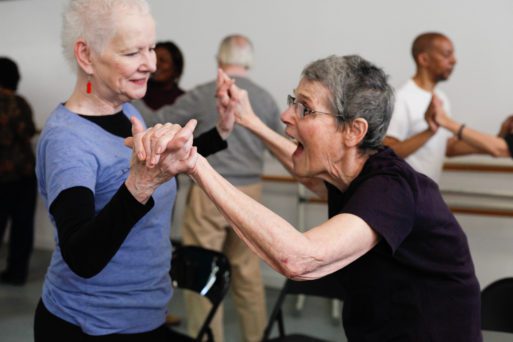
A dancer enjoys class with a partner.
Why has Dance for PD been so successful?
Dance fits Parkinson’s like a glove. It’s a very well designed art form for people dealing with a movement disorder that also impacts quality of life. PD isn’t just about the motor symptoms. It’s the social/emotional issues as well. It affects mood, anxiety, and fatigue. Apathy is a huge clinical issue in Parkinson’s. It’s a terrible feeling of having no desire, no will to get up and out or do anything. Dance, in addition to providing all of the physical benefits, provides the answer to the question, “What is going to get me up and out everyday?” Dance, with its musical, social and playful aspects, is a very attractive physical activity that other forms may not provide. When given the option to run on the treadmill or salsa with their friends, most choose salsa. I’m convinced some people come just for the social aspect of the class.
It’s word of mouth throughout the Parkinson’s community that has really helped the growth and success of Dance for PD. Also, our participants tell their doctors how much dance has changed their lives. Many doctors have now completed peer-reviewed studies that back up the idea that dance greatly benefits those living with PD. In New York, our community is already bent toward arts and culture, so we invited neurologists in to our classes and allowed them to participate and see the positive impact on our dancers. There are now a number of medical centers all over the world that offer our Dance for PD class. In 2014, director Dave Iverson filmed a documentary, titled Capturing Grace, on our class and its impact on the community. It aired on PBS and was widely viewed, so if anyone was on the fence about the possible benefits of dance, the film certainly put any doubts to rest.
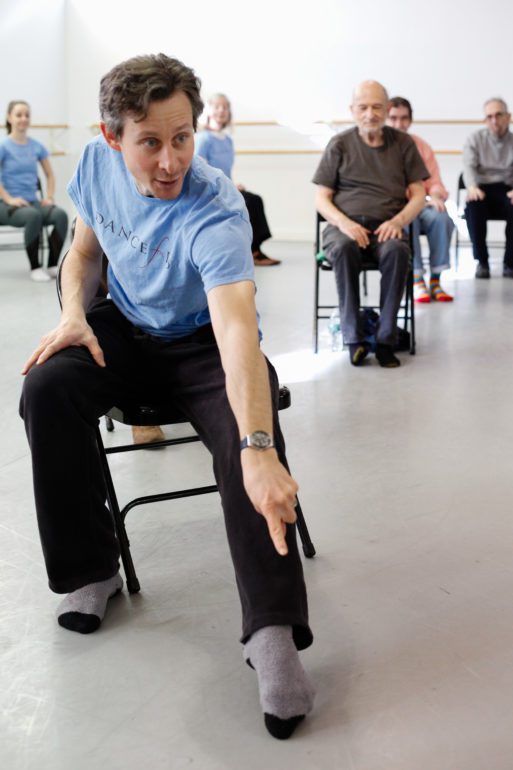
David Leventhal teaches a class how to dance seated.
How are dance and healing connected? Had you thought about this connection prior to Dance for PD?
Before Dance for PD, I hadn’t thought of how the two were connected. The whole idea of dance as a part of healthcare is both ancient and very recent. Prior to our modern time, many indigenous cultures combined the arts and healing. Music, drawing, dance — these were all parts of the healing process. It’s only in our modern societies that we’ve separated art and medicine. In the past few decades, we have begun to see the collaborative effect of art and healing. When people dance, they’re using multiple parts of their brain. There’s music, movement, visual input — it’s a very stimulating activity. As we have begun to understand more about the brain, we’ve only scratched the surface of how valuable the arts can be. Using arts as a form of therapy or healing ritual is not a new idea. We’re only just now embracing it again.
Have you ever had anyone come to class who felt resistant to dancing?
Yes, it happens frequently. Some people have to overcome their fears of having Parkinson’s and being in public. For others, the idea of dance is very intimidating. There can be hesitation for many reasons. We try to mitigate that by bringing in many different forms of dance at an accessible, fun level. We’re not trying to trick people or frustrate people. We use warm-up exercises that help dancers to use everyday tasks to get into the dance, such as moving like a baseball player. We think of how people will throw a pitch or swing a bat as a starting place for movement. People may not think they want to dance ballet or learn ballet moves, but what they do in our class are real ballet moves.
I know that everyone has different styles of dance that they connect with or enjoy more. We try to incorporate several styles in each class. Salsa, for example, is a wonderful dance for those with motor issues. It helps to practice shifting weight and bending the knees. Even people in wheelchairs or who need to remain seated can complete all of the moves. All of our dances can be done seated. Even those with incredibly limited mobility can do something, even if it’s just moving their fingers. We always remind partners that even if their loved one does not look like they’re doing much, they are. Their mind is still completing the moves, and that’s beneficial, too. Even just to engage socially is enough of a reason to continue to come to class.
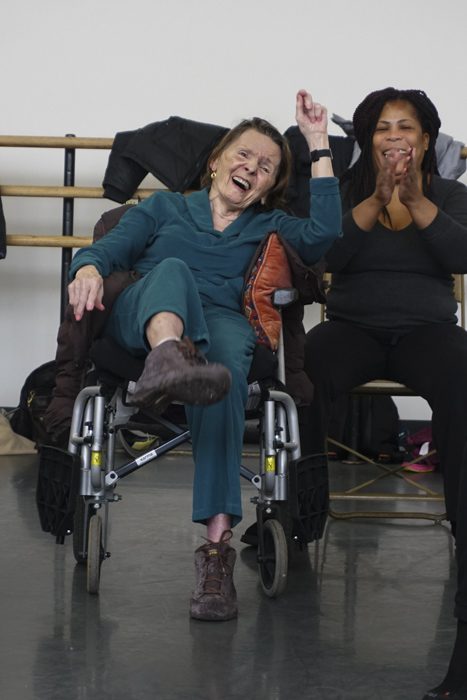
A wheelchair can’t stop this dancer from enjoying the Dance for PD class.
What’s one tip you would give to someone who’s living with a Parkinson’s diagnosis and wants to improve their quality of life?
The key is to find something that you love and want to do. It needs to be something that doesn’t feel like an onerous path, but inviting. Maybe that’s dance, maybe not, but you have to find something and do it. That’s what will sustain them.
Even if it’s not dance, anyone can think like a dancer. There are four key components to thinking and living like a dancer.
- Use music as much as you can. Have music as your support whenever you do anything — washing dishes or taking a walk. Choose music that matches the rhythm of your activity.
- Think of movement as choreography. Think about how you move as a dance. For example, if it takes 16 steps to get to the bathroom, I can think of the pattern of my feet and “dancify” my everyday movements.
- Think of yourself as a performer. With Parkinson’s, the movements tend to get smaller, the voice gets quieter. There’s an overall drawing in of everything. But, if you’re on stage, you think about big movements, big attitude, big voice. Think about being onstage in everyday life.
- Lastly, use imagery. Imagine a scene or movement that works for you — perhaps the sun rising — as the movement that gets you out of bed, for instance. Use those images to help you move through your daily life. When motor skills are difficult to access, set images can help people get through daily challenges.

 How Dance Can Help People With Functional Limitations Become Their Best Selves
How Dance Can Help People With Functional Limitations Become Their Best Selves


 How Dare You Die Now!
How Dare You Die Now!
 Debating Medical Aid in Dying
Debating Medical Aid in Dying
 “Help Me, Helen”
“Help Me, Helen”














